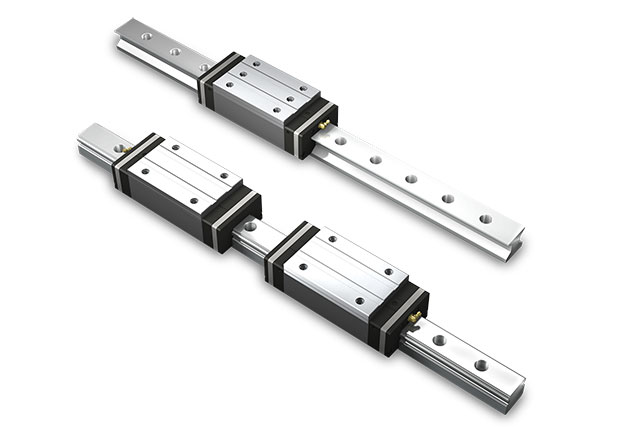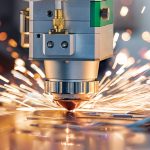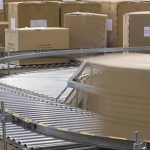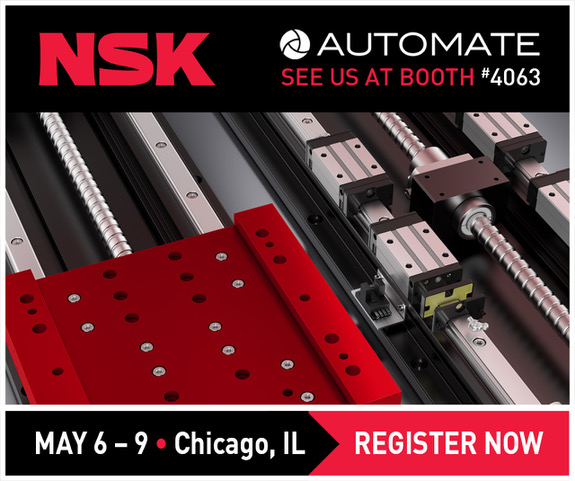Table Of Contents
- What Are Linear Guide Rails?
- Fundamental Role of Linear Guide Rails in Various Industries
- Importance of Linear Guide Rails in Precision Engineering
- Types of Linear Guide Rails
- Benefits of Linear Guide Rails
- Linear Guide Rails in Industrial Automation
- Considerations When Choosing Linear Guide Rails
- Retrofitting Existing Devices with Advanced Linear Guide Rail Systems
 When you are implementing a linear motion system, there are several options for the components in that system. Linear guide rails are one of the best options for smooth motion, high load bearing capacity, precise movement, and corrosion resistance. Linear guide rails provide quiet movement with low vibration that is a benefit in many different applications.
When you are implementing a linear motion system, there are several options for the components in that system. Linear guide rails are one of the best options for smooth motion, high load bearing capacity, precise movement, and corrosion resistance. Linear guide rails provide quiet movement with low vibration that is a benefit in many different applications.
What Are Linear Guide Rails?
Linear guide rails are part of a linear motion system made up of several components. The linear guide rail functions as the stationary base, with a moving carriage incorporating rolling elements. Linear guide rails will be installed and mounted for smooth linear motion where needed and are often part of a larger linear motion system. Linear guide rails are typically manufactured from steel for superior rigidity and stability, but can be customized for different industry needs. Linear guide rails can be manufactured with other materials or composites for increased corrosion resistance, reduced weight, or with self-lubricating properties. Linear guide rails can be sealed to avoid contamination in environments where this is a concern.
Fundamental Role of Linear Guide Rails in Various Industries
Linear guide rails play a fundamental role in the linear motion systems present in applications across a wide range of industries.
 Manufacturing
Manufacturing
Linear guide rails are a major component in the linear motion systems present in CNC machines, milling machines, and lathes for precise cutting and shaping processes in the manufacturing industry. As these manufacturing processes rely on smooth motion, a high degree of precision, and low vibration, linear guide rails provide the right foundation for the necessary linear motion.
 Automation
Automation
Automation of processes is becoming more and more prevalent in many different industries to increase efficiency and accuracy of repeated tasks. Linear guide rails are integrated into robotic arms, automated assembly lines, and pick-and-place systems for accurate and swift movements. The high load capacity, reliability, and smooth motion provided by linear rails keeps these automated systems functioning consistently with minimal downtime.
 Medical Technology
Medical Technology
Linear guide rails are important in the linear motion systems present in medical technology. Linear guide systems are used in medical imaging devices, such as CT scanners, MRIs, and X-ray imaging, as well as surgical robots and diagnostic equipment, ensuring a high degree of precision in medical procedures and diagnostic techniques. The medical industry faces a high degree of regulation with accuracy and precision as well as low vibration being important to meeting the standards required. Linear guide rails can provide this level of precision.
 Electronics
Electronics
Linear guide systems incorporating linear guide rails play a large role in semiconductor manufacturing equipment and electronics assembly machines for intricate component placements that require a high degree of precision. These processes require low vibration, smooth motion, and extreme accuracy. In addition, linear guide rails work well in cleanroom environments, which is where many of these processes take place.
 Packaging
Packaging
Packaging processes often require smooth motion and high load bearing capabilities, and linear guide rails have the load capacity to support a robust packaging process. Linear guide rails are integrated into conveyor systems and labeling machines, enhancing efficiency in packaging processes. The smooth motion that can be repeated with minimal downtime is a definite benefit to packaging systems.
 Aerospace
Aerospace
The aerospace industry requires a high degree of precision. Linear guide rails have applications in tasks like drilling, riveting, and assembly for precision and reliability in aerospace manufacturing. Linear guide rails can be customized to be lightweight and low-maintenance, which is a benefit for aerospace manufacturing where systems are designed to be as lightweight as possible.
Automotive Industry: Precision Inspection of Engine Components
Linear motion systems are present in many applications in the automotive industry, but one of the greatest benefits of these systems comes in the advantage they can provide in the inspection of engine components. In the automotive industry, linear guide rails find an application in automated inspection systems for engine components such as cylinder heads and crankshafts. Linear guide rails enable smooth and accurate movement of inspection probes, with micron-level precision in measurements. With this level of precision, linear guide rails are able to work in systems for the detection of minor defects and deviations in components, which helps to ensure quality and reliability in automotive engines and other components of automotive manufacturing.
Electronics Manufacturing: Inspection of Printed Circuit Boards (PCBs)
Linear guide rails have been used in electronics manufacturing, and more specifically, the inspection of printed circuit boards (PCBs). Automated Optical Inspection (AOI) systems for PCBs are important to ensure that PCBs will function as anticipated, and this inspection system is often included as part of the prototyping stage of development. Linear guide rails facilitate precise movement of cameras and sensors over PCB surfaces. The linear motion system that drives the AOI system maintains consistent focus and alignment during inspection. This inspection provides high-resolution imaging of circuitry for defect detection as well as accurate identification of soldering issues, missing components, and misalignments. By utilizing a linear guide system within the inspection process, there can be rapid identification and rectification of manufacturing errors before a large-scale production run.
Importance of Linear Guide Rails in Precision Engineering
When precision is important, linear guide rails should be a part of any linear motion system, as they are superior to alternative options in precision and accuracy.
Ensuring Accuracy
Although smooth linear motion is important, accuracy is critical in precision engineering. Using linear guide rails guarantees precise movement, which is critical for manufacturing intricate components with tight tolerances. Linear guide rails have the ability for micron-level precision in their applications.
Enhancing Efficiency
Efficiency is important in precision engineering and manufacturing. The more efficiently the systems can run, the greater the output and the bigger the reduction in energy costs. Linear guide rails, as part of a linear motion system, are effective in reducing vibrations and friction, when then leads to higher efficiency and productivity in machines.
Enabling Complex Operations
Many processes in precision engineering are highly complex and require automated or robotic applications to complete these operations with the necessary degree of precision required. Linear guide rails allow for these complex operations, such as 5-axis machining, which enables the creation of intricate designs and shapes.
Improving Quality
Having a high-quality product is critical to success in precision engineering and manufacturing. Linear guide systems contribute to the overall quality of products by ensuring consistent, high-quality precision manufacturing. The high degree of precision, smooth and repeatable motion, low vibration, and quiet operation all contribute to the superior quality that can be found when using linear guide rails.
Types of Linear Guide Rails
There are several different types of linear guide rails, usually distinguished by the rolling elements that are housed within the carriage. Although linear guide rails that use plain, or sliding, bearings are also an option, the most effective linear guide rails have some sort of rolling element.
Ball Bearing Linear Guide Rails
Ball bearing linear guide rails consist of recirculating ball bearings contained in a carriage on a linear guide rail. Ball bearing linear guide rails have the advantages of low friction, a long lifespan, and high precision and accuracy. Because ball bearings reduce surface contact, they are able to operate with extremely smooth linear motion, making them very effective in applications that require a high degree of precision.
Roller Linear Guide Rails
Roller linear guide rails have a cylindrical rolling element contained within the carriage on the linear guide rail. Roller bearing systems are suitable for heavy-duty applications, as the roller allows for a high-load capacity and a long lifespan with low maintenance needs. Many manufacturing, packaging, and conveyor systems utilize linear guide rails with rollers.
Benefits of Linear Guide Rails
Using linear guide rails as part of a linear motion system has many benefits, including a high degree of precision, smooth and quiet operation, and low friction. As linear guide rails have low maintenance requirements, they can operate with minimal downtime, increasing overall efficiency.
Precision and Accuracy
Linear guide rails ensure precise movement and accurate positioning in machines and equipment through the smooth motion provided by the rolling elements. By reducing surface contact through the recirculating rolling, friction is greatly reduced. This results in improved accuracy and a higher quality product in manufacturing processes.
Smooth and Quiet Operation
Reduced friction provided by a linear guide rail also provides the benefit of smooth and noiseless movement. Although noise is not always a concern, quiet operation is crucial in certain industries, such as in medical and laboratory equipment. Smooth motion is critical in medical equipment, and quiet operation with low friction and vibration helps to ensure patient comfort and safety.
Linear Guide Rails in Industrial Automation
Linear guide rails are important in industrial automation. Many different applications can benefit from incorporating a linear motion system that relies on linear guide rails.
Enabling Robotic Precision
Linear guide rails can enable robotic precision. High precision movements in robots used for delicate assembly and material handling tasks are greatly enhanced with linear motion systems that utilize linear guide rails. The smooth motion, low vibration, and exceptional precision in robotic applications are crucial to industrial automation.
Ensuring Scalable Reliability
Consistent and reproducible motion is essential for applications requiring identical movements in every cycle. These reproducible motions are most effectively performed by automated systems utilizing linear rail systems. Linear rails within a linear motion system are highly accurate with smooth, repeatable motion. Automated processes can be consistently repeated when these systems are incorporated.
Facilitating Speed and Efficiency
Speed and efficiency are important in the automotive industry, and this can be achieved by incorporating linear rail systems. Linear rail systems have the advantage of reducing friction and enabling high-speed automation, which ultimately leads to faster production cycles and increased throughput. The low maintenance requirements and high reliability of linear rail systems contributes to reduced down time, which further increases efficiency.
Enhancing Safety
Safety is paramount in the automotive industry, and the increased reliance on automated processes can keep human workers out of harm’s way. Linear guide rails, when used in an automated process, enhance safety by preventing collisions and ensuring accurate and necessary interaction with human workers and other machinery, enhancing the safety of automated systems. With consistent and repeatable motion, tasks will always be completed accurately and safely.
Considerations When Choosing Linear Guide Rails
There are several factors to consider when choosing linear guide rails. Load capacity needs, durability, precision needs, environmental factors, and maintenance needs should always be considered. Although there are many standard solutions that will work well for most applications, customization for unique needs is always an option.
Load Capacity and Durability
For any engineering design, determining load capacity is important. Linear guide rails are typically able to handle high load capacity. The dynamic load calculations are crucial to avoiding failure once the linear guide system is integrated. Load capacity is calculated for both dynamic and static loads. Static loads are the load on the system in a fixed, unmoving position, while dynamic load refers to how the load can be moved through the system. If the load is calculated incorrectly, the system can see increased friction, low precision, and even the failure of the rail. As linear guide rails are available in a variety of load capacities, it is important to understand the needs of your application before settling on your selection. In addition to the dynamic load capacity, it is important that the load is distributed evenly across the rail and rolling elements. This will help reduce any stress on the linear guide system that can lead to premature failure.
Environmental Factors
Environmental conditions such as dust and moisture can impact the linear guide rails you choose. When corrosion is a concern, choosing corrosion resistant materials or opting for a corrosion resistant coating can help protect your linear guide rail. Temperature and humidity should also be considered, as most linear guide systems have a top temperature rating of 80 degrees C, and if more extreme temperatures are possible, other options may need to be considered. Contamination is also a concern. If the environment will be subject to contamination from dirt or dust, sealing the linear guide system can help keep the system working smoothly between regularly scheduled proactive maintenance.
Considerations for OEMs When Selecting Linear Guide Systems
OEMs will need to consider several factors when selecting the linear guide system that will work best for their application.
Customized, Tailored Solution
Most reputable linear guide manufacturers offer customization options to meet specific OEM requirements. Every application has unique needs, and while standard components may work, the best solutions often come from customization. The benefits of tailored solutions include optimal fit, reduced assembly time, and seamless integration into OEM products. The specific operating environment can be analyzed, and the ideal materials and design can be incorporated.
Collaboration with Manufacturers
OEMs have the opportunity to collaborate closely with linear guide manufacturers during the product design phase, and should make sure to take advantage of what this can provide. The advantages of collaborative efforts include expert guidance, product testing, and access to the latest technological advancements.
Cost-Effectiveness and Total Cost of Ownership
When choosing a linear guide rail system, cost is always a concern. Depending on the needs of the application, different options are available. However, when implementing a new linear guide rail, it is important to consider the total cost of ownership (TCO) rather than just the initial cost of linear guide systems. Investing in high-quality linear guide systems can lead to long-term cost savings through reduced maintenance, fewer replacements, and enhanced product reputation. Taking the time to look at the TCO and the benefits a high-quality linear guide system will bring often demonstrates the value in the initial investment.
Retrofitting Existing Devices with Advanced Linear Guide Rail Systems
While installing new equipment that incorporates advanced linear guide rail systems has many benefits, there is the option of retrofitting existing devices and equipment with new linear guide rail systems. This can allow businesses to enjoy the benefits while avoiding the high cost of replacing equipment that is still functional.
Enhanced Performance
High performance is always the operational goal. Retrofitting with advanced linear guide rails can significantly enhance the precision and accuracy of the existing device’s movements, which is crucial in applications such as CNC machines and measurement equipment. In addition, upgrading to high-quality linear guide systems can minimize vibrations, leading to smoother and more stable operations. By retrofitting with advanced linear guide rail systems, the benefits of enhanced performance can be realized.
Increased Lifespan
Equipment lifespan is important, as replacing equipment can cause significant downtime. Retrofitting with durable and corrosion-resistant linear guide rails can extend the lifespan of the present equipment, minimizing downtime. This is especially important in industrial environments where machines are subjected to wear and harsh conditions.
Cost-Effectiveness
Avoiding complete replacement is something that is critical to many businesses. Complete equipment replacement comes at a high cost and is not usually feasible. Retrofitting is often more cost-effective than replacing the entire device. Retrofitting with advanced linear guide rail systems allows businesses to upgrade the performance of their equipment without the significant cost of purchasing a new machine. In addition, retrofitting can contribute to lower maintenance costs. Advanced linear guide systems require less maintenance which will reduce operational costs over time and provide long-term savings overall.
Adaptability and Customization
Although there are similarities across industries, every system has its own unique needs. Finding tailored solutions is important for the success of your business. Retrofitting allows for the integration of linear guide rails tailored to specific requirements. Manufacturers can choose systems that precisely fit the dimensions and load-bearing capacity needed. In addition, retrofitting allows for adaptation to new requirements. Devices and existing equipment must often adapt to new tasks or increased workloads. Retrofitting allows for modifications to accommodate these changing demands without the need to replace the equipment entirely.
Environmental Compliance
Environmental regulations are becoming more common in nearly every industry, with everyone being challenged to become more sustainable, efficient, and aware of their environmental impact and how that impact can be reduced. Energy efficiency is the goal of every new piece of equipment, technology, or system. New linear guide systems often come with energy-efficient features, contributing to environmental sustainability and compliance with energy efficiency regulations. As replacing equipment is not typically environmentally responsible, retrofitting legacy equipment with a newer linear guide system that utilizes linear guide rails is an excellent way to meet environmental compliance requirements while saving on costs and creating a more efficient process.
Performance Optimization
Optimizing the performance of your equipment is important to stay competitive in most industries, but replacing equipment is not always possible, and is certainly not a sustainable strategy. Using linear guide rails can optimize the performance of many different applications in a variety of industries. Linear guide rails offer faster speeds and accelerations over other options for linear motion. Upgraded linear guide systems can handle higher speeds and accelerations, enabling the device to work more efficiently and increase productivity. Rather than replacing equipment with systems that incorporate linear guide rails, retrofitting with upgraded and advanced linear guide rails can optimize performance as well as reduce noise levels during operation.
Technological Advancements
Technology will continue to advance. Many industries do not have the resources to replace and upgrade their systems with every new technological advancement, but that does not mean that they are stuck with dated processes. With retrofitting, businesses can have access to new technology without needing to replace every piece of equipment. Retrofitting existing equipment with linear guide rails allows businesses to take advantage of the latest advancements in linear guide technology by incorporating linear guide rails as part of linear motion systems into their existing equipment, enabling them to stay competitive in the market, take advantage of all the benefits provided by linear guide rails, and enjoy a cost savings over replacement.
Sustainability
Sustainability is, or should be, important to every industry moving forward. Reduced waste, lowered energy requirements, and the continued use of legacy systems can all contribute to a culture of sustainability. Retrofitting legacy processes with linear guide rails promotes sustainability by reducing electronic waste and making existing systems more efficient. Most legacy systems can easily be retrofitted with linear guide rails at a far lower cost than replacing an existing system with one that incorporates the latest in linear motion technology. Upgrading existing devices ensures their continued use, saving time and money while reducing waste that comes from replacing processes that still have a place in the industry.
Elevate Your Operations with Customized NSK Linear Guide Rail Systems
Linear guide rails offer many benefits and a significant advantage over other options for processes relying on linear motion. However, not every linear guide rail is the right fit, and it is important to choose the right linear guide rail for your specific industry and application. Contact NSK for guidance on your production needs, your operating environment, and which linear guide system will work best for what you want and need it to do.

